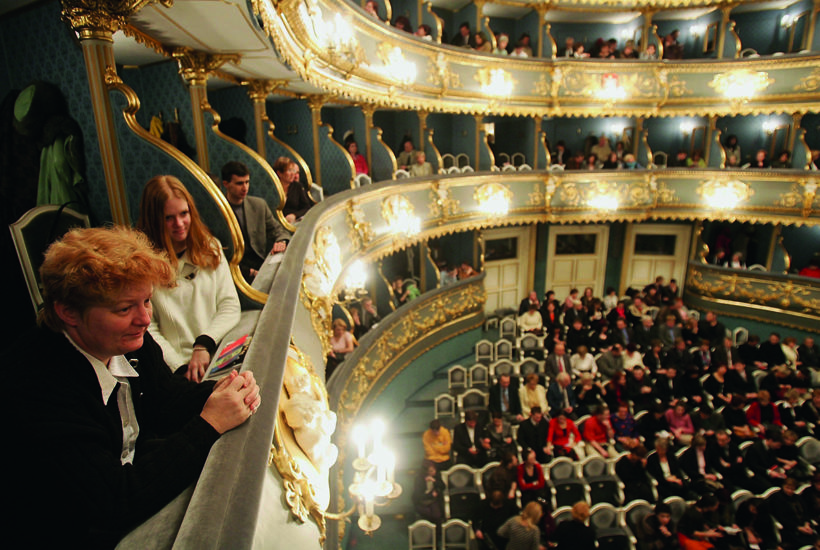The family that plays together…
It’s 1771, you’re in Milan, and your 14-year-old genius son has just premiered his new opera. How do you reward him? What would be a fun family excursion in an era before multiplexes or theme parks? Leopold Mozart knew just the ticket. ‘I saw four rascals hanged here on the Piazza del Duomo,’ wrote young Wolfgang back to his sister Maria Anna (‘Nannerl’), excitedly. ‘They hang them just as they do in Lyons.’ He was already something of a connoisseur of public executions. The Mozarts had spent four weeks in Lyons in 1766, and, as the music historian Stanley Sadie points out, Leopold had clearly taken his son (10) and daughter (15) along to a hanging ‘for a jolly treat one free afternoon’.
Mozart’s letters deliver many such jolts — reminders that, however directly we might feel that Mozart’s music speaks to us, he’s not a man of our time. But for every shock of difference, there’s a start of recognition. Composers’ letters can make frustrating reading. Beethoven’s are brusque, practical affairs. Brahms hides behind a humor as impenetrable as his beard. But with Mozart, you get the whole personality — candid, perceptive and irresistibly alive.
Reading Mozart’s correspondence is like being tugged by an enthusiastic, garrulous friend right into the green room of 18th-century European culture. The cast list extends from Empress Maria Theresa to the family dog Bimperl: Mozart is just as fascinated by both. One minute, he’s dressed as Harlequin and dancing all night at the 1783 Vienna carnival. Next, he’s talking shop with Dad (Leopold was a respected composer in his own right), or bitching about a mediocre singer or arrogant patron. Now he’s arriving in Linz without a symphony in his luggage, and writing a new one overnight before getting back to the equally compelling business of lavatory humor.
That’s probably the most notorious aspect of Mozart’s letters: the filth. Quite how gamey they get varies with the translation. The classic English version — some 616 letters covering the period 1762 to 1791 — comes in three fat volumes, translated by Emily Anderson in 1938 in the best possible taste. More recent paperback selections by Robert Spaethling and Stewart Spencer are less reserved: ‘I’ll shit on your nose so it runs down your chin,’ writes the 21-year-old Wolfgang to his cousin Maria in Augsburg, and if you’ve seen Amadeus, you’ll know that there’s plenty more where that came from. (Mrs Thatcher famously disapproved of the scatology.) One advantage of Anderson’s edition (and Spencer’s 2006 translation) is that it includes letters from the rest of the Mozart family, and it’s clear that they were all at it — mother, father, daughter and son, all cheerfully potty-mouthing away. ‘Stick your tongue up your crack,’ Nannerl urges her brother.
Meanwhile, in the background, we glimpse a concerto or an aria on the workbench. But surprisingly rarely. The exception comes in Munich in late 1780, when Wolfgang’s letters to Leopold suddenly become a daily production diary for Idomeneo. He coaches the singers: the castrato ‘has to learn his part like a child’. There’s a new scene change, ‘so I composed a short march for strings and oboes’. Leopold sends a parcel from Salzburg with trumpet mutes and a fresh pair of stockings, but ‘the ballet-master is an insufferable wind-bag and bore’, and makes Wolfgang miss the mail coach. We’re witnessing a man of the theater in his element: it’s more like a Broadway memoir by Sondheim or Lerner than Lives of the Great Composers.
And occasionally, magically, it all joins up. Here he is in Milan a few days before his 17th birthday, writing gibberish to Nannerl: ‘I for the primo a homo motet to make had tomorrow that performed will be. Well be to you I ask. Farewell. Addio.’ The ‘primo a homo’ was the castrato Rauzzini, and the ‘motet’ was Exsultate, jubilate K.165 — which Mozart had completed days earlier. Its exuberant finale throws the single word ‘Alleluia’ every which way against the rhythm, just as the boy chops and changes the syntax of that playful letter home.
At moments like this, Mozart’s life, personality and art are all of a piece. Almost our final glimpse of him is in October 1791, writing to his wife Constanze with no idea that he’d be dead before Christmas. ‘I played two games of billiards…then I had Joseph fetch me some black coffee, with which I smoked a glorious pipe of tobacco,’ he writes. ‘Then I orchestrated almost the entire Rondo of the Stadler concerto’ — in other words, the Clarinet Concerto: the sensuous, bittersweet masterpiece that we’re far too ready to call the swansong of a man who was actually enjoying life intensely. The marvel of Mozart’s letters is that you don’t need to know the music to experience that joy, though it’s even more wonderful when you do.
This article is in The Spectator’s August 2020 US edition.
